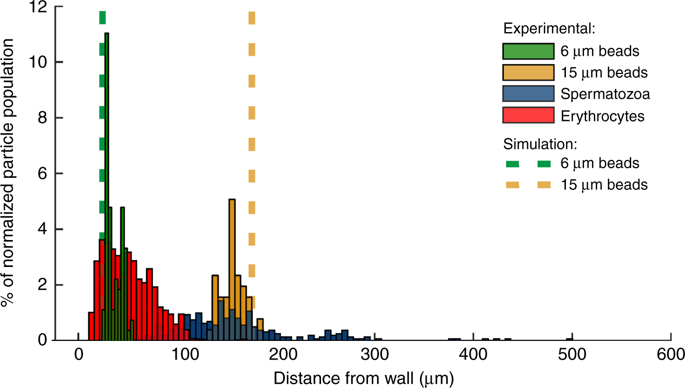Microsystems & Nanoengineering ( IF 7.3 ) Pub Date : 2019-05-20 , DOI: 10.1038/s41378-019-0068-z Johanna T W Berendsen 1 , Jan C T Eijkel 1 , Alex M Wetzels 2 , Loes I Segerink 1, 2

|
Men suffering from azoospermia can father a child, by extracting spermatozoa from a testicular biopsy sample. The main complication in this procedure is the presence of an abundance of erythrocytes. Currently, the isolation of the few spermatozoa from the sample is manually performed due to ineffectiveness of filtering methods, making it time consuming and labor intensive. The spermatozoa are smaller in both width and height than any other cell type found in the sample, with a very small difference compared with the erythrocyte for the smallest, making this not the feature to base the extraction on. However, the length of the spermatozoon is 5× larger than the diameter of an erythrocyte and can be utilized. Here we propose a microfluidic chip, in which the tumbling behavior of spermatozoa in pinched flow fractionation is utilized to separate them from the erythrocytes. We show that we can extract 95% of the spermatozoa from a sample containing 2.5% spermatozoa, while removing around 90% of the erythrocytes. By adjusting the flow rates, we are able to increase the collection efficiency while slightly sacrificing the purity, tuning the solution for the available sample in the clinic.
中文翻译:

使用夹流分级装置中的翻滚机制从红细胞中分离精子
患有无精子症的男性可以通过从睾丸活检样本中提取精子来生育孩子。该过程的主要并发症是存在大量红细胞。目前,由于过滤方法效率低下,从样本中分离少量精子是人工进行的,既费时又费力。精子的宽度和高度都比样本中发现的任何其他细胞类型都小,与最小的红细胞相比差异非常小,因此这不是提取的依据。然而,精子的长度是红细胞直径的 5 倍,可以利用。在这里,我们提出了一种微流控芯片,其中利用挤压流分级中精子的翻滚行为将它们与红细胞分离。我们表明,我们可以从含有 2.5% 精子的样本中提取 95% 的精子,同时去除大约 90% 的红细胞。通过调整流速,我们能够提高收集效率,同时略微牺牲纯度,调整临床可用样品的解决方案。











































 京公网安备 11010802027423号
京公网安备 11010802027423号